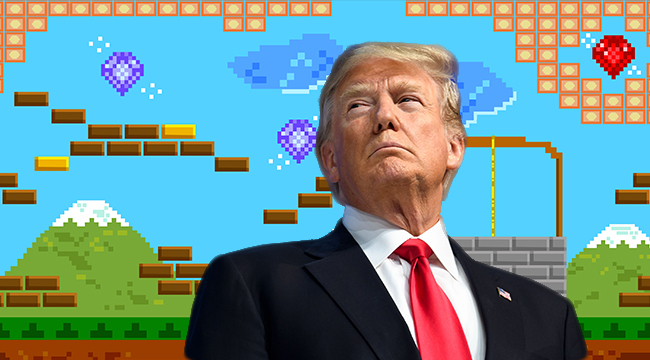
In 2012, in the wake of the mass murder of Sandy Hook, the head of the NRA, Wayne LaPierre, announced a press conference. In it, he insisted to reporters that it wasn’t guns that caused this tragedy, it was “filthy pornography,” specifically 1990s pop culture like Natural Born Killers and video games like Mortal Kombat. A video game about a monk who throws his razor-sharp hat at thunder gods and a sick joke of a browser game lurking in the depths of the internet, LaPierre insisted, was the real problem.
Few people bought this, of course. Not even LaPierre seems to, in video for the speech, but that wasn’t the point. LaPierre wanted to create a distraction, to get people off the topic of how guns are used to commit murder in America. It was, in short, an waste of effort better spent trying to stop tragedy.
History, many think, is set to repeat itself. Donald Trump, surprising both his advisers and the video game industry, has announced he’ll meet with gaming executives, much like Joe Biden did after the Sandy Hook murders. And it promises to be a mess, according to the Daily Beast:
Knowledgeable sources says that the Trump White House has scrambled to cobble together some semblance of a serious policy meeting. And much of the heavy lifting for putting the session together, according to those briefed on the matter, has fallen to White House Director of Legislative Affairs Marc Short and Director of Strategic Communications Mercedes Schlapp. But as of Tuesday afternoon, it was not clear who, exactly, would attend, who was invited, and whether the Thursday meeting would be televised or not, according to multiple sources in and out of the Trump administration.
This meeting could be bright and cordial, or it could be dour, but either way, it’s not going to accomplish anything. The debate over government control of video games ended In 2011 with the decision Brown V. Entertainment Merchants Association. The Supreme Court of the United States ruled that video games were protected speech under the First Amendment, striking down a California law that sought to ban the sales of violent video games to children under 18 and setting extremely high scientific standards before it would revisit the issue.
That makes government regulation of video games all but impossible. The industry instead self-regulates, as it has for years, with the Entertainment Software Ratings Board, or ESRB, rating video games on a scale from Kids to Adults Only. Many retailers, such as industry titan GameStop, require ID and consent of a parent to sell games rated Mature to anyone under 17. Kids can find ways around the system, because kids always do, but it’s generally effective in that parents are usually present and know what kids are buying.
Furthermore, video game systems are everywhere. Sony and Microsoft have, between them, moved well over forty million of their current video game consoles in the United States, building on strong sales of the PlayStation and Xbox brands. And yet, as their stars have risen, violent crime has been on a steady decline. It’s unlikely the two are connected, of course, but then, that’s the whole point. If the data says they’re not connected, this meeting will accomplish nothing.
It’d make more sense for Trump to invite domestic violence counselors and survivor advocacy groups to discuss the link between mass shootings and domestic violence, about how women are hunted in their workplaces. It’d make more sense to discuss a bipartisan bill reflecting the overwhelming popularity of gun control measures among gun owners, not to mention the American populace. Or he could host academics to lay out studies showing the effectiveness of gun control laws that would have little impact on gun ownership beyond paperwork, but would drop the mortality rate from firearms from 10.1 for every 100,000 to 0.16 for every 100,000 Americans.
But far more important, and constructive, would be hearings on semi-automatic rifles, because in the United States, homicide with rifles is extraordinarily rare. There were 11,004 gun homicides in America in 2016, but only 374 of those were known to have been committed with rifles. And yet, mass shooters have increasingly used rifles where they once used handguns almost exclusively. The deadliest shootings of the last decade have all been with semi-automatic rifles. This is a strange trend, as U.S. manufacturers make far more handguns than they do semi-automatic rifles. It seems that understanding why it’s the tool of choice for premeditated mass murder is a question worth asking.
Instead, executives who create puppet shows out of electrons and math will troop into the White House on Thursday. They may be met with respect, or they may be met with contempt. But no matter what, they probably won’t solve anything.
